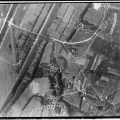Historic Military Events
The images within the National Collection of Aerial Photography can be used to identify and interpret key historical moments and to see events unfolding as they happened. Below are just a few examples of the types of images that are held in the archive and show how you can identify key features within the photographs themselves to learn about or re-examine history.
The Second World War
Normandy Landings 1944
The Holocaust: Auschwitz
Operation Clarion 1945
Colditz Prisoner of War Camp 1945
Liberation celebrations: Copenhagen 1945
Logistics
The Suez Crisis 1956
This Feature was prepared by a Skills for the Future trainee.








